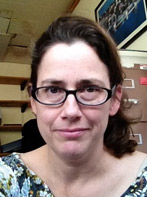Maria Gallegos Faculty Profile

Maria Gallegos
Associate Professor
Department of Biological Sciences
- E-mail: maria.gallegos@csueastbay.edu
- Phone: (510) 885-2856
- Office: SC-N418
My lab is interested in neurodevelopment. We want to understand how a neuron's complex morphology is not only established but maintained throughout the life of an animal. Our long-term goal is to identify the genes and understand the molecular mechanisms that specifically control late steps in neurodevelopment by exploiting the experimental advantages and anatomical simplicity of the nematode, Caenorhabditis elegans. Conserved molecules required to build this worm’s simple nervous system often function to regulate neurodevelopment in higher eukaryotes. Our hope is that the conserved molecules we identify might function similarly in mammals during development and within the context of injury or disease. For example, genes that act to terminate neurite growth as the nervous system forms might also hinder regrowth in severed axons that fail to regenerate.
- Ph.D. University of Wisconsin, Madison
| Course # | Sec | Course Title | Days | From | To | Location | Campus |
|---|---|---|---|---|---|---|---|
| BIOL 410 | 01 | Genetic Analysis II | TTH | 2:45PM | 4:00PM | SC-N125 | Hayward Campus |
| BIOL 490 | 08 | Independent Study | ARR | ARR | Hayward Campus | ||
| BIOL 622 | 01 | ADV Molecular Techniques | TTH | 10:25AM | 10:50AM | SC-N406 | Hayward Campus |
| BIOL 622 | 1A | ADV Molecular Techniques | TTH | 11:00AM | 1:30PM | SC-N406 | Hayward Campus |
| BIOL 681 | 04 | Research | ARR | ARR | Hayward Campus | ||
| BIOL 690 | 02 | Independent Study | ARR | ARR | Hayward Campus | ||
| BIOL 690 | 04 | Independent Study | ARR | ARR | Hayward Campus |
Gallegos, M. and Sanjeev Balakrishnan et al. (Under Final Review for Publication). The C. elegans Rab family: Identification, Classification and Toolkit Construction. (D. Dupuy, Ed.) PloS One.
O'Halloran, D. M., Hamilton, O. S., Lee, J. I., Gallegos, M., & L'Etoile, N. D. (2012). Changes in cGMP Levels Affect the Localization of EGL-4 in AWC in Caenorhabditis elegans. (D. Dupuy, Ed.) PloS One, 7(2), e31614.
Gallegos, M. and Bargmann, C. (2004). Mechanosensory neurite termination and tiling are directed by SAX-2 and the SAX-1 kinase. Neuron 44(2):239-249.